TURCO 5884
TURCO 5884
TURCO 5884
Create successful ePaper yourself
Turn your PDF publications into a flip-book with our unique Google optimized e-Paper software.
<strong>TURCO</strong> <strong>5884</strong>MATERIAL SAFETY DATA SHEET1PRODUCT AND COMPANY IDENTIFICATIONHenkel Surface TechnologiesHenkel Corporation32100 Stephenson HighwayMadison Heights, MI 48071Information Telephone NumbersEMERGENCY PHONE NUMBER:Chemtrec: (800) 424-9300 (24hrs)Phone Number(284) 583-9300Available HrsProduct NameProduct Synonym(s)Chemical FamilyChemical FormulaChemical NameEPA Reg NumProduct Use<strong>TURCO</strong> <strong>5884</strong>Aromatic Hydrocarbon MixtureNA - MixtureJet Engine Gas Path Cleaner2 COMPOSITION / INFORMATION ON INGREDIENTSIngredient Name CAS RegistryNumber Typical Wt. % OSHAHeavy aromatic petroleum solvent napthaWaterTriethanolamineOctylphenoxy polyethoxyethanolFatty AcidHexylene glycol2-Butoxy ethanolCoconut oil diethanolamideNaphthaleneDiethanolamineBenzotriazoleThe substance(s) marked with a "Y" in the OSHA column, are identified as hazardous chemicals according to thecriteria of the OSHA Communication Standard (29 CFR 1910.1200)The components of this product are all on the TSCA inventory list.64742-94-57732-18-5102-71-69036-19-5Proprietary107-41-5111-76-268603-42-991-20-3111-42-295-14-735-50%20-35%1-10%5-15%5-10
<strong>TURCO</strong> <strong>5884</strong>MATERIAL SAFETY DATA SHEETPotential Health EffectsInhalation and skin contact are expected to be the primary routes of occupational exposure to this material. Thisdistillate is variable in composition, but typically contains isomers of trimethylbenzene. Hydrocarbons of this type mayremove oils from the skin and, because of their drying nature, produce irritation, redness and rash with repeated orprolonged contact. High vapor concentrations (>1000 ppm) are irritating to the eyes and respiratory tract, and mayresult in central nervous system (CNS) effects, with possible effects such as headache, dizziness, anesthesia,drowsiness, nausea, vomiting, tremors, and in severe exposures, loss of consciousness and death.While swallowing of this material is unlikely in the industrial setting, if swallowed this material may cause digestive tractirritation, nausea, vomiting and CNS effects as noted above. There may be mild to severe injury if the material is drawninto the lungs (aspirated) during swallowing, or during spontaneous or induced vomiting after swallowing. Symptoms ofinjury may include increased breathing and heart rates, coughing and related signs of respiratory distress.4 FIRST AID MEASURESIF IN EYES, immediately flush with plenty of water. Get medical attention if irritation persists.IF ON SKIN, Wash with plenty of soap and water. Get medical attention if irritation persists.IF SWALLOWED, do NOT induce vomiting. Give water to drink. Get medical attention immediately. NEVERGIVE ANYTHING BY MOUTH TO AN UNCONSCIOUS PERSON.IF INHALED, remove to fresh air. If not breathing, give artificial respiration. If breathing is difficult, giveoxygen. Get medical attention.5 FIRE FIGHTING MEASURESFire and Explosive PropertiesAuto-Ignition TemperatureFlash PointFlammable Limits- UpperLowerExtinguishing MediaFire Fighting InstructionsFire and Explosion HazardsNE145 deg FNENEUse carbon dioxide, dry chemical or foamFlash Point MethodUse water spray. A solid stream of water can cause frothing and spattering. Fire fighters and others who maybe exposed to products of combustion should wear full fire fighting turn out gear (full Bunker Gear) and selfcontainedbreathing apparatus (pressure demand NIOSH approved or equivalent). Fire fighting equipmentshould be thoroughly decontaminated after use.Avoid breathing fumes from fire exposed material.TCCProduct Code: 238805 Revision: 1 Issued: 04 JUN 2001Page 2 of 11
<strong>TURCO</strong> <strong>5884</strong>MATERIAL SAFETY DATA SHEET6ACCIDENTAL RELEASE MEASURESIn Case of Spill or LeakIsolate hazard area and deny entry to unnecessary or unprotected personnel. Contain spilled liquid with sandor earth. Clean up spill immediately, observing precautions in the Personal Protection section of MSDS. Avoidrunoff into storm sewers and ditches which lead to waterways.7HANDLING AND STORAGEHandlingDo not get in eyes, on skin or clothing. Avoid breathing vapor or mist. Keep container closed. Use only withadequate ventilation. Wash thoroughly after handling. Empty container may contain hazardous residues. Keepaway from heat, sparks and flame. Use explosion proof equipment.StorageStore in a cool, dry place. Avoid excessive heat. Store out of direct sunlight in a cool, well-ventilated place.8EXPOSURE CONTROLS / PERSONAL PROTECTIONEngineering ControlsInvestigate engineering techniques to reduce exposures below airborne exposure limits. Provide ventilation ifnecessary to control exposure levels below airborne exposure limits (see below). If practical, use localmechanical exhaust ventilation at sources of air contamination such as open process equipment. ConsultACGIH ventilation manual or NFPA Standard 91 for design of exhaust systems.Eye / Face ProtectionWhere there is potential for eye contact, wear chemical goggles and have eye flushing equipment immediatelyavailable.Skin ProtectionNitrile or Neoprene gloves should be worn when handling this material. Wear face shield and chemicalresistant clothing such as a rubber apron when splashing may occur. Wash contaminated clothing and cleanprotective equipment before reuse. Rinse contaminated skin promptly. Wash skin thoroughly after handling.Respiratory ProtectionAvoid breathing vapor or mist. When airborne exposure limits are exceeded (see below), use NIOSH approvedrespiratory protection equipment appropriate to the material and/or its components. Consult respiratormanufacturer to determine appropriate type equipment for given application. Observe respirator use limitationsspecified by NIOSH or the manufacturer. For emergency and other conditions where exposure limit may besignificantly exceeded, use an approved full face positive-pressure, self-contained breathing apparatus orpositive-pressure airline with auxiliary self-contained air supply. Respiratory protection programs must complywith 29 CFR § 1910.134.Airborne Exposure Guidelines for IngredientsExposure LimitTriethanolamineACGIH TWA-Hexylene glycolACGIH CEILING-DiethanolamineValue5 mg/m325 ppm (121 mg/m3)Product Code: 238805 Revision: 1 Issued: 04 JUN 2001Page 3 of 11
<strong>TURCO</strong> <strong>5884</strong>MATERIAL SAFETY DATA SHEETDiethanolamineACGIH Skin designatorACGIH TWA2-Butoxy ethanolACGIH Skin designator-ACGIH TWA-OSHA Skin designator-OSHA TWA PEL-Heavy aromatic petroleum solvent napthaACGIH STELACGIH TWANaphthaleneACGIH Skin designatorACGIH STELACGIH TWAOSHA TWA PEL---As naphthalene-As naphthalene----Y0.46 ppm 2 mg/m3Y20 ppm (97 mg/m3)Y50 ppm (240 mg/m3)15 ppm10 ppmY15 ppm (79 mg/m3)10 ppm (52 mg/m3)10 ppm (50 mg/m3)-Only those components with exposure limits are printed in this section.-Skin contact limits designated with a "Y" above have skin contact effect. Air sampling alone is insufficient to accurately quantitateexposure. Measures to prevent significant cutaneous absorption may be required.-ACGIH Sensitizer designator with a value of "Y" above means that exposure to this material may cause allergic reactions.9 PHYSICAL AND CHEMICAL PROPERTIESAppearance/OdorpHSpecific GravityVapor PressureVapor DensityMelting PointFreezing PointBoiling PointSolubility In WaterOther Physical DataClear, amber fluid8.8-9.2 (conc)0.96 - 0.97NENENANE> 200 deg FEmulsifiesVOC = 417 G/LProduct Code: 238805 Revision: 1 Issued: 04 JUN 2001Page 4 of 11
<strong>TURCO</strong> <strong>5884</strong>MATERIAL SAFETY DATA SHEET10 STABILITY AND REACTIVITYStabilityThis material is chemically stable under normal and anticipated storage and handling conditions.Hazardous PolymerizationHazardous polymerization is not known to occur.IncompatibilityAvoid contact with strong acids and oxidizers. Contact with these materials may result in an exothermic reaction,characterized by heat and violent splattering of chemicals involved.Hazardous Decomposition ProductsOxides of carbon, nitrogen compounds.11 TOXICOLOGICAL INFORMATIONToxicological InformationData on this material and/or its components are summarized below.NaphthaleneSingle exposure (acute) studies indicate that this material is slightly toxic to rats if swallowed (LD50 1,700-2,400mg/kg), practically non-toxic to slightly toxic to rats if absorbed through skin (LD50 1,100 to >20,000 mg/kg), andslightly irritating to rabbit skin and eyes. Workplace experience indicates that short term overexposure to thismaterial by inhalation causes headache, nausea, eye and upper respiratory irritation, digestive tract pain, andvomiting. Inhalation of high concentrations of this material has been reported to cause hemolysis of the blood,kidney damage and secondary effects on the liver and brain. Human case reports indicate that short termoverexposure to this material by absorption through the skin or swallowing causes hemolytic anemia,hemoglobinuria and, in severe cases, death. Studies of workers exposed in dye manufacturing operations withthis material have demonstrated that the material causes cataracts.Following repeated oral exposure to this material, slight kidney changes, cataracts and eye damage wereobserved in rats; cataracts and eye damage were observed in rabbits; and, no significant adverse effects wereobserved in mice. Skin damage, but no systemic effects, were observed in rats following repeated skinexposure to this material. Inflammation of the lungs and upper respiratory tract and damage to the lining of thenose and lungs were observed in long-term inhalation studies in mice. This material increased the incidence oftumors in long-term inhalation studies in mice, but not in long-term oral studies in rats. No birth defects werenoted in the offspring of rats, mice or rabbits given naphthalene orally during pregnancy. This material generallyproduced no genetic changes in standard tests using bacterial or animal cells and animals.Hexylene GlycolSingle exposure (acute) studies indicate that this material is slightly toxic to rats, rabbits, mice and guinea pigsif swallowed (LD50 2,800-4,700 mg/kg), practically non-toxic to rabbits if absorbed through skin (LD50 12,300mg/kg), severely irritating to rabbit eyes, and moderately irritating to rabbit skin. No deaths occurred in ratsexposed to about 160 ppm for 8-hours. Skin application of 50% of this material in water showed only minimalirritation in human volunteers, while repeated application of consumer products containing up to 1% showed noirritant or sensitizing effects in humans. Patch tests have shown sensitization responses in individuals workingwith cutting oils containing this material. Rats and rabbits exposed to 0.7 mg/l for 9 days showed no adverseProduct Code: 238805 Revision: 1 Issued: 04 JUN 2001Page 5 of 11
<strong>TURCO</strong> <strong>5884</strong>MATERIAL SAFETY DATA SHEET11 TOXICOLOGICAL INFORMATIONeffects. This material in the diet at up to 150 mg daily for 4 months produced no adverse effects on growth,behavior or fertility in rats. Changes in the kidney were noted at 200 mg/day. No genetic changes wereobserved in tests using bacteria or animal cells.2-Butoxy ethanolSingle exposure (acute) studies indicate that this material is slightly to moderately toxic if swallowed (rat LD50450-2,700 mg/kg), moderately toxic if absorbed through skin (rabbit LD50 404-1,804 mg/kg), slightly toxic ifinhaled (rat 4-hr LC50 2.18 - >3.87 mg/l), moderately to severely irritating to rabbit eyes, and mildly irritating torabbit skin. Oral administration of this material to rats did not cause immunosuppression. Rats given thismaterial orally (222 mg/kg/day or above) for 6 weeks showed red blood cell changes which resulted in spleen,liver and kidney effects including increased spleen and liver weight. This material given orally for a longerperiod (13 weeks) also exhibited effects on blood (anemia), liver and spleen, as well as reduced body weightgain and reduced thymus weight at dosages of 280 mg/kg/day or above. Reduced weight gain was the onlyeffect observed in a 13-week drinking study with mice at much higher dosages. When rats were exposed to thismaterial by inhalation in either long or short-term studies, decreased weight gain and blood effects werereported. A short-term repeated skin application study (9 applications of 360 mg/kg), reported skin damage andblood in the urine of rabbits. However, no adverse effects were reported in rabbits exposed to this material bylong-term (13-week) repeated and prolonged skin applications (up to 150 mg/kg/day). No birth defects wereobserved in rats, rabbits or mice exposed to this material by inhalation (rats and rabbits), oral (rats and mice) ordermal (rats) routes, even at levels which produced toxic effects on the mothers and their offspring. Thismaterial has generally produced no genetic changes in a variety of standard tests using bacterial or animalcells.TriethanolamineSingle exposure (acute) studies indicate that this material is practically non-toxic if swallowed (rat LD50 4,200-11,200 mg/kg), no more than slightly toxic if absorbed through skin (rabbit LD50 >2,000 mg/kg), slightly tomoderately irritating to rabbit eyes and non-irritating to rabbit skin (4-hr occluded exposure). Skin application atconcentrations above 5% produced mild skin irritation in human volunteers, but generally showed no evidenceof allergic skin reaction. No allergic skin reactions were observed in guinea pigs following repeated exposure.In rats, repeated inhalation exposure produced increased liver weight and inflammation of the larynx, while inmice, larynx irritation and decreased white blood cell counts were observed. Repeated exposure of rats in thediet resulted in decreased body weights, liver and kidney damage, and alterations in the optic nerves. Repeatedapplication to the skin of rats resulted in skin lesions, but no systemic effects. The National Toxicology Program(NTP) has conducted repeated and long-term dosing studies by skin application in mice and rats which showedinflammation of the skin and some evidence of kidney damage. Mice showed some evidence of carcinogenicitybased on increase in liver tumors, but the evaluation was complicated by the presence of infectious diseaseknown to enhance liver cancer. Male rats, but not females, showed evidence of kidney tumor formation judgedto be equivocal. Long-term administration in drinking water showed no evidence of carcinogenicity in rats ormice. Skin application to pregnant rats produce no increase in birth defects in the offspring. No geneticchanges were observed in tests using bacteria or animal cells.BenzotriazoleSingle exposure (acute) studies indicate that this material is slightly to moderately toxic to rats if swallowed(LD50 500 - 1,072 mg/kg), practically non-toxic to rabbits if absorbed through skin (LD50 > 10,000 mg/kg),slightly toxic to rats if inhaled (3-hr LC50 1.91 mg/l), moderately irritating to rabbit eyes and practically nonirritatingto slightly irritating to rabbit skin. This material produced no genetic changes in bacterial and animalcells.Product Code: 238805 Revision: 1 Issued: 04 JUN 2001Page 6 of 11
<strong>TURCO</strong> <strong>5884</strong>MATERIAL SAFETY DATA SHEET11TOXICOLOGICAL INFORMATIONOctylphenoxy polyethoxyethanolSingle exposure (acute) studies indicate that this material is slightly toxic to rats if swallowed (LD50 4,920mg/kg, MW 250), practically non-toxic to rabbits if absorbed through skin (LD50 >16,000 mg/kg, MW 250) andrats if inhaled (no deaths after 1-hr exposure to 21.5 mg/l, MW 624), slightly to moderately irritating to rabbit skin(4-hr exposure, MW 250) and severely irritating to rabbit eyes (MW 250 and 624). Administration (average MW624) in the diet of pregnant rats caused an increase in the number of ribs in the fetuses at a level sufficient tocause maternal toxicity. No genetic changes were observed in standard tests using bacteria and animal cells.Coconut oil diethanolamideSingle exposure (acute) studies indicate that this material is slightly toxic to rats if swallowed (LD50 2,700mg/kg). There have been a few case reports of allergic contact dermatitis from repeated contact with thismaterial. This material is widely used in cosmetic and toiletry articles such as soaps, detergents and shampoosand has not been reported to cause notable skin problems. This material has not produced genetic changes instandard bacterial tests.12ECOLOGICAL INFORMATIONEcotoxicological InformationData on this material and/or its components are summarized below.NaphthaleneThis material is moderately toxic to Daphnia magna (EC50 2.16-8.6 mg/l), Artemia salina (EC50 3.19-10.64mg/l), Gammarus minus (EC50 3.93 mg/l), Oreochromis mossambicus (LC50 7.9 mg/l), green algae (EC502.82-5.7 mg/l) and fathead minnow (LC50 1.99-7.9 mg/l). It is highly toxic to rainbow trout (LC50 0.11-1.6 mg/l)and Micropterus salmoides (LC50 0.51-0.68 mg/l).Hexylene GlycolThis material has been reported to be practically non-toxic to a variety of aquatic organisms by acute toxicitytesting. Freshwater fish including rainbow trout, bluegill sunfish, fathead minnow, mosquito fish, goldfish andchannel catfish had LC50 values in excess of 1,000 mg/l and generally were in the range of 8,000 to 10,000mg/l. Aquatic invertebrates such as Daphnia and crayfish had EC50 values greater than 2,800 mg/l.2-Butoxy ethanolThis material is practically non-toxic to goldfish (24-hr LC50 1,700 mg/l), brown shrimp (48-hr 800 mg/l),Daphnia magna (48-hr LC50 835 mg/l), bluegill sunfish (96-hr LC50 127-1,460 mg/l), fathead minnow (96-hrLC50 2,137 mg/l), tidewater silversides (96-hr LC50 1,250 mg/l) and green algae (7-day EC50 >1,000 mg/l).This material did not inhibit the growth of Pseudomonas fluorescens.TriethanolamineThis material is practically non-toxic to aquatic organisms on an acute basis with LC50 values generally >100mg/l for all species tested. Acute LC50 values for fish such as fathead minnow, bluegill, golden orfe andgoldfish range from 1800-7930 mg/l. Acute LC50 values for invertebrate species such as Daphnia magna andbrine shrimp range from 1390-5600 mg/l. Acute EC50 values for algae are >470 mg/l.BenzotriazoleThis material is slightly toxic to bluegill sunfish 96-hr (TLM 25 ppm), minnow (TLM 28 ppm) and trout (12 ppm).Product Code: 238805 Revision: 1 Issued: 04 JUN 2001Page 7 of 11
<strong>TURCO</strong> <strong>5884</strong>MATERIAL SAFETY DATA SHEET12 ECOLOGICAL INFORMATIONOctylphenoxy polyethoxyethanolThis material is moderately toxic to freshwater trout (LC50 7.2 mg/l) and fathead minnow (96-hr LC50 8.9 mg/l,MW 624).Chemical Fate InformationData on this material and/or its components are summarized below.Hexylene GlycolChemical oxygen demand (COD) and biological oxygen demand (BOD) indicated that this material is readilybiodegraded.2-Butoxy ethanolThis material has a high biological oxygen demand and is considered to be readily biodegradable.Biodegradation reached 74% in the Modified Sturm carbon dioxide evolution test. This material consumed >70%of the theoretical oxygen demand, with no inhibition of the test system, in the Closed Bottle test. Biochemicaloxygen demand (BOD) using unadapted and adapted sewage seed was .70 gram oxygen consumed/gramproduct and 1.63 gram oxygen consumed/gram product, respectively. BOD of unadapted sewage seed was30% of the theoretical oxygen demand and for adapted sewage seed was 71% of the theoretical oxygendemand. The Chemical oxygen demand (COD) is 2.18 gram oxygen consumed/gram product.TriethanolamineThis material is readily biodegradable and passes the OECD test for ready biodegradability. It is over 99%degraded in activated sludge in 24 hours, soil in 14 days, and river water in 20-35 days. This material has a lowoctanol/water partition coefficient and would not be expected to bioaccumulate in aquatic species or foodchains.BenzotriazoleThere was no primary biodegradation with this material.13 DISPOSAL CONSIDERATIONSWaste DisposalRecover, reclaim or recycle when practical. Dispose of in accordance with federal, state and local regulations.Note: Chemical additions to, processing of, or otherwise altering this material may make this wastemanagement information incomplete, inaccurate, or otherwise inappropriate. Furthermore, state and localwaste disposal requirements may be more restrictive or otherwise different from federal laws and regulations.Product Code: 238805 Revision: 1 Issued: 04 JUN 2001Page 8 of 11
<strong>TURCO</strong> <strong>5884</strong>MATERIAL SAFETY DATA SHEET14 TRANSPORT INFORMATIONDOT NameDOT Technical NameDOT Hazard ClassUN NumberDOT Packing GroupRQNot Regulated by the DOTPG15 REGULATORY INFORMATIONHazard Categories Under Criteria of SARA Title III Rules (40 CFR Part 370)Immediate (Acute) Health Y FireNDelayed (Chronic) Health N ReactiveNSudden Release of Pressure NThe components of this product are all on the TSCA inventory list.Ingredient Related Regulatory Information:SARA Reportable QuantitiesTriethanolamineHexylene glycolDiethanolamine2-Butoxy ethanolFatty AcidHeavy aromatic petroleum solvent napthaCoconut oil diethanolamideWaterOctylphenoxy polyethoxyethanolNaphthaleneBenzotriazoleCERCLA RQNENE100 LBSNENENENENENE100 LBSNESARA TPQNESARA Title III, Section 313This product does contain chemical(s) which are defined as toxic chemicals under and subject to the reporting requirements of, Section313 of Title III of the Superfund Ammendments and Reauthorization Act of 986 and 40 CFR Part 372. See Section 22-Butoxy ethanolDiethanolamineNaphthaleneChemical Weapons ConventionTriethanolamineMassachusetts Right to KnowThis product does contain the following chemicals(s), as indicated below, currently on the Massachusetts Right to Know SubstanceList.Product Code: 238805 Revision: 1 Issued: 04 JUN 2001Page 9 of 11
<strong>TURCO</strong> <strong>5884</strong>MATERIAL SAFETY DATA SHEETMassachusetts Right to KnowThis product does contain the following chemicals(s), as indicated below, currently on the Massachusetts Right to Know SubstanceList.2-Butoxy ethanolBenzotriazoleDiethanolamineHexylene glycolNaphthaleneTriethanolamineNew Jersey Right to KnowThis product does contain the following chemical(s), as indicated below, currently on the New Jersey Right-to-Know Substances List.2-Butoxy ethanolDiethanolamineHexylene glycolNaphthalenePennsylvania Environmental HazardThis product does contain the following chemical(s), as indicated below, currently on the Pennsylvania Environmental Hazard List.2-Butoxy ethanolDiethanolamineNaphthalenePennsylvania Right to KnowThis product does contain the following chemical(s), as indicated below, currently on the Pennsylvania Hazardous Substance List.2-Butoxy ethanolDiethanolamineHexylene glycolNaphthaleneTriethanolamine16 OTHER INFORMATIONRevision InformationRevision DateSupercedes Revision Dated04 JUN 2001Revision SummaryInitial Entry into Henkel Surface Technology Product Line.Revision Number 1KeyNE= Not Established NA= Not Applicable (R) = Registered TrademarkProduct Code: 238805 Revision: 1 Issued: 04 JUN 2001Page 10 of 11
<strong>TURCO</strong> <strong>5884</strong>MATERIAL SAFETY DATA SHEETThe information presented herein is believed to be factual as it has been derived from the works and opinionsof persons believed to be qualified experts; however, nothing contained in this information is to be taken as awarranty of representation for which Henkel Surface Technologies bears legal responsibility. The user shouldreview any recommendations in the specific context of the intended use to determine whether they areappropriate.Product Code: 238805 Revision: 1 Issued: 04 JUN 2001Page 11 of 11


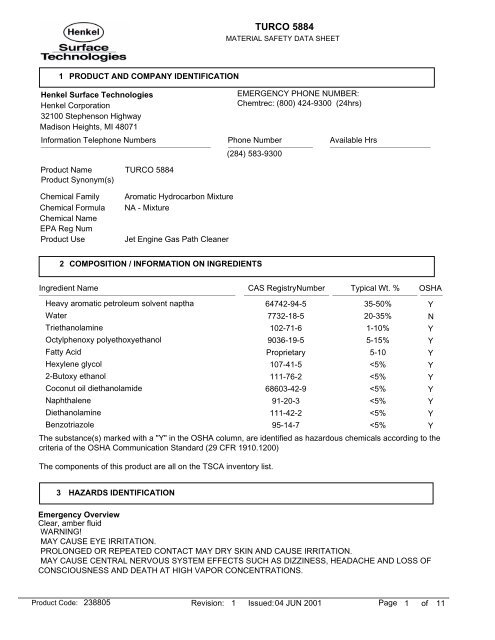
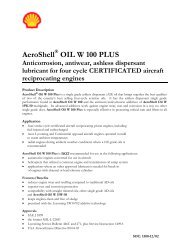
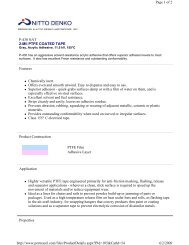
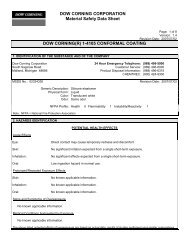
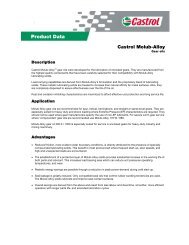
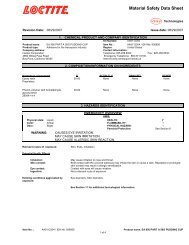
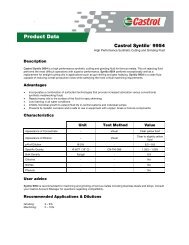
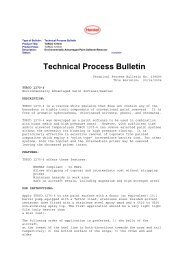
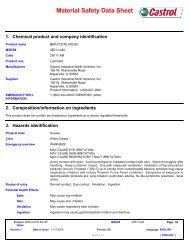
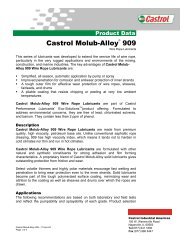

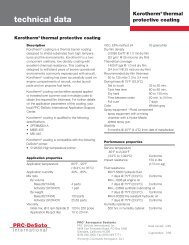

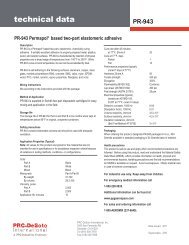
![3368 Rustilo 4169 (English (GB)) BP EU SDS - Italy [IT-SIBU-Castrol]](https://img.yumpu.com/46809112/1/184x260/3368-rustilo-4169-english-gb-bp-eu-sds-italy-it-sibu-castrol.jpg?quality=85)